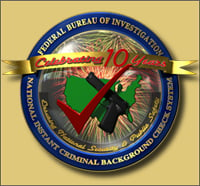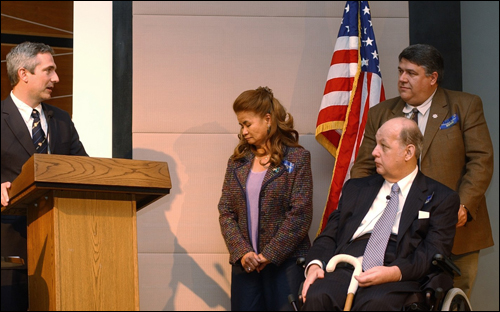NICS Celebrates 10 Years of Operation
 |
FBI’s Gun Buyer Background Check System Marks 10 Years of Operation
On November 30, 2008, the National Instant Criminal Background Check System (NICS) Section of the FBI’s Criminal Justice Information Services Division celebrated a 10-year milestone. The NICS, which ensures the timely transfer of firearms to eligible gun buyers and prevents firearms from being purchased by those prohibited from doing so, became operational on November 30, 1998.
The Brady Act spurs development of the NICS
The creation of the background check system was the result of an amendment to the Gun Control Act of 1968.
In March 1981, White House Press Secretary James S. Brady was seriously wounded in an assassination attempt on President Ronald Reagan. In 1985, Mr. Brady’s wife, Sarah Brady, joined an effort to place stricter regulations on the transfer of firearms and develop reasonable gun control laws.
FBI Deputy Assistant Director Jerome M. Pender, left, speaks to James S. Brady, former Press Secretary to President Ronald Reagan, during Brady’s visit to the CJIS Division’s West Virginia facility in 2005. Also pictured are Mr. Brady’s personal assistant (second from left) and John Shanks, Midwest Regional Director of the Brady Campaign to Prevent Gun Violence.
A result of this campaign occurred in November 1993, when the Brady Handgun Violence Prevention Act of 1993 (Brady Act) was signed into law. The Brady Act requires Federal Firearms Licensees (FFLs) to request background checks on individuals attempting to purchase a firearm (both long guns and handguns). The permanent provisions of the Brady Act, which went into effect on November 30, 1998, required the Attorney General to establish the NICS so that any FFL may request an immediate determination on whether the receipt of a firearm by a prospective gun buyer would violate federal or state law.
 |
|---|
|
FBI Deputy Assistant Director Jerome M. Pender, left, speaks to James S. Brady, former Press Secretary to President Ronald Reagan, during Brady’s visit to the CJIS Division’s West Virginia facility in 2005. Also pictured are Mr. Brady’s personal assistant (second from left) and John Shanks, Midwest Regional Director of the Brady Campaign to Prevent Gun Violence. |
How the NICS works
When an FFL requests a NICS check, a name search for any matching records is conducted using three databases—the National Crime Information Center (NCIC), the Interstate Identification Index (III), and the NICS Index. Each background check includes an automated search of more than 61 million criminal history records, including records on wanted persons and subjects of protective/restraining orders. During its first 10 years of operation, the NICS processed more than 90 million background checks.
To accomplish a shared mission of ensuring public safety through information sharing, the NICS Section works in partnership with the U.S. Department of Justice; the U.S. Immigration and Customs Enforcement; the Bureau of Alcohol, Tobacco, Firearms and Explosives; the point-of-contact states (states which coordinate their own state’s background checks); and other local, state, and federal law enforcement agencies.
Throughout the last 10 years, advances in technology have improved the availability of information to the NICS legal instruments examiners (NICS examiners) who process the background checks, enabling them to provide more accurate, timely, and reliable services to the FFLs and the customers they serve. Also, two major endeavors have increased the efficiency of the checks: (1) the growth of the NICS Index and (2) retrieval of final disposition information for hundreds of thousands of criminal history records.
The NICS Index established
The NICS Index was established to maintain information on individuals determined to be federally prohibited from purchasing or possessing firearms who have disqualifying information not available through the NCIC and III systems researched during a background check. There are 11 prohibited categories utilized for entry of individuals into the NICS Index. The categories are:
- Conviction of a crime punishable by more than one year or a misdemeanor punishable by more than 2 years;
- Under Indictment/Information;
- Fugitive from Justice;
- Unlawful User/Addicted to a Controlled Substance;
- Adjudicated Mental Defective/Committed to a Mental Institution;
- Illegal/Unlawful Alien;
- Dishonorable Discharge;
- Citizenship Renunciants;
- Protection/Restraining Order;
- Misdemeanor Crime of Domestic Violence Conviction; and
- Federally Denied Persons.
A potential gun buyers’ descriptive information, when matched with a NICS Index record, will result in an immediate denial. The NICS Section continues to educate state and federal agencies on the importance of submitting individuals for entry into the NICS Index. Currently, the NICS Index contains over 5 million records. Shooting incidents such as the Virginia Tech massacre, which occurred in April 2007, have motivated agencies to participate in submission of prohibited individuals to the NICS Index.
Disposition information retrieved
One major obstacle the NICS Section encountered when operations began and continues to face is the lack of final disposition information on many criminal history records. (For example, the NICS might have arrest information on a person who, if convicted of the charges, would be prohibited from purchasing a firearm. NICS staff must confirm through court documentation whether or not the person was convicted.) Over the past 10 years, the NICS Section has been instrumental in updating more than 650,000 criminal history records with final disposition information. These dispositions were obtained by the NICS examiners through persistent and resolute research with courts and law enforcement agencies.
Today, with a staff of nearly 500 employees, the NICS Section continues to be diligent and dedicated in ensuring the timely transfer of firearms to those legally authorized to purchase them while denying transfers to felons, fugitives, and other prohibited persons. Looking forward, a new NICS modernization initiative is on the horizon. This initiative will improve the NICS infrastructure and refresh the technology that drives the system. It will also provide many other benefits, such as more efficient information sharing with law enforcement partners and enhanced customer service to FFLs.
07.09.10
General Information
- Fact Sheet
- Index Brochure (pdf)
- Overview Brochure (pdf)
- Participation Map
Appeals
- Appeals/Voluntary Appeal File Process
- Frequently Asked Questions
- Guide to Appeals Brochure - English (pdf) | Español (pdf)
- Voluntary Appeal File Brochure - in English (pdf) | Español (pdf)
- Standard Fingerprint Form (pdf)
- Attorney Release Form (pdf)
Videos

|
 |
|
NICS Voluntary Appeal File (VAF) |
NICS Process (for Customers) |

|

|
| NICS E-Check |
NICS Process (for Dealers) |
Resources For Federal Firearms Licensees
Reports and Statistics
- Operations Reports: 2014 (pdf) | 2013 | 2012 | 2011 (pdf) |
2010 (pdf) | 2009 | 2008 | 2007 | 2006 | 2005 | 2003/2004 |
2001/2002 | 2000 (pdf) | 1998/1999 (pdf)
- Active Records in the NICS Index (pdf)
- Active Records in the NICS Index by State (pdf) | Press release
- Federal Denials (pdf)
- NICS Firearm Checks: Month/Year (pdf)
- NICS Firearm Checks: Month/Year by State (pdf)
- NICS Firearm Checks: Month/Year by State/Type (pdf)
- NICS Firearm Checks: Year by State/Type (pdf)
- NICS Firearm Checks: Top 10 Highest Days/Weeks (pdf)
News and Stories
- 2013: NICS Turns 15
- 2011 Testimony
- 10th Anniversary Story | Speech | Photos

